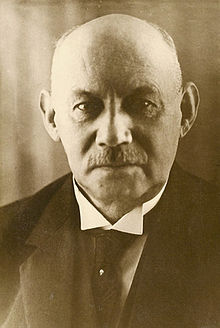Ernst Ehrhardt
Ernst Ehrhardt (born September 6, 1855 in Staßfurt , † August 6, 1944 in Bremen ; full name: Ernst Friedrich Heinrich Ehrhardt ) was a German architect and Prussian building official and master builder in Bremen.
biography
Ehrhardt was the son of a mining machine foreman and manager of a mine owned by Harpener Bergbau-AG in Bochum . He attended secondary school and studied structural engineering and architecture at the Technical University of Charlottenburg . After graduating, he worked for the Reich Railway Administration in Alsace-Lorraine , where he worked on building structures. In 1885 he passed the second state examination to become a government architect ( assessor ). From 1888 to 1895 he traveled to Italy to get to know the local architecture better. From 1895 to 1897 he worked in the church building department at the Prussian Ministry of Public Works in Berlin, during which time the Evangelical Church on Markt in Blankenese and 1896-1897 the Evangelical Church of Thanks in Holtenau near Kiel were built according to his designs.
In 1897 Ehrhardt became master builder for the Bremen Cathedral in Bremen as successor to Max Salzmann . He completed the restoration work on the cathedral, which had begun in 1888, by 1901. During support work on the cathedral foundation, the bones of Archbishop Liemar († 1101) , believed to be lost, were found. Ehrhardt's son, born in 1901, was given the unusual first name Liemar. The beautification work on the front of the Schütting (magnificent portal, two-flight flight of stairs) on Bremen's market square was completed by him by 1899. In 1899 the tower blower fountain was built on the south-western corner of the cathedral according to his design .
From 1901 to 1908 Ehrhardt was again active in the Prussian civil service and then returned to Bremen. In 1908 he became the building director and head of the building construction department that was created in 1907 (later the Bremen building department ) at the Bremen building department . He and his two building inspections (right and left of the Weser) monitored a. a. work on the new Bremen town hall (1909–1913), the commercial building (1912–1913) and the various school and hospital buildings of this time.
In 1920 Ehrhardt ended his work in the public service and dealt with scientific work on the building history of Bremen. He mainly dealt with the preparation of the inventory of Bremen monuments and art monuments, which was later completed by the Bremen monument conservator Rudolf Stein .
The Ernst-Ehrhardt-Straße in Bremen- Obervieland was named in 1966 after him.
Works
- 1897: New Raths pharmacy in Bremen (with Max Salzmann )
- 1900: Renewal of the crossing pillars in Bremen Cathedral (with Max Salzmann)
- 1900: Restoration of the Schütting in Bremen (with Max Salzmann)
- 1902–1905: Construction management for the new building for the Imperial Patent Office in Berlin (Architects: Hermann Solf , Franz Wichards )
- 1915: Commercial building in Bremen
literature
- Wilhelm Wortmann : Bremen builder of the 19th and 20th centuries. (published by the Bremen Development Community) Döll-Verlag , Bremen 1988, ISBN 3-88808-056-8 , p. 38 f.
- Herbert Black Forest : The Great Bremen Lexicon . 2nd, updated, revised and expanded edition. Edition Temmen, Bremen 2003, ISBN 3-86108-693-X .
- Rudolf Stein : Ehrhardt, Ernst Friedrich Heinrich. In: Historical Society Bremen, State Archive Bremen (Ed.): Bremische Biographie 1912–1962. Hauschild, Bremen 1969, p. 133 (column 1) to p. 134 (column 1).
Individual evidence
- ↑ a b Bert Morio: The Dankeskirche and the parish Holtenau. In the Internet portal Holtenauer Geschichte , accessed on October 13, 2017
- ^ Zeitschrift für Bauwesen , Volume 47, 1897, p. 361 f.
- ↑ Zeitschrift für Bauwesen , Volume 50, 1900, pp. 295–302.
- ^ The Preservation of Monuments , year 1900, pp. 9–11.
- ^ The Preservation of Monuments , year 1915, pp. 89–94.
| personal data | |
|---|---|
| SURNAME | Ehrhardt, Ernst |
| ALTERNATIVE NAMES | Ehrhardt, Ernst Friedrich Heinrich (full name) |
| BRIEF DESCRIPTION | German architect and Prussian building officer, master builder in Bremen |
| DATE OF BIRTH | September 6, 1855 |
| PLACE OF BIRTH | Staßfurt |
| DATE OF DEATH | August 6, 1944 |
| Place of death | Bremen |
